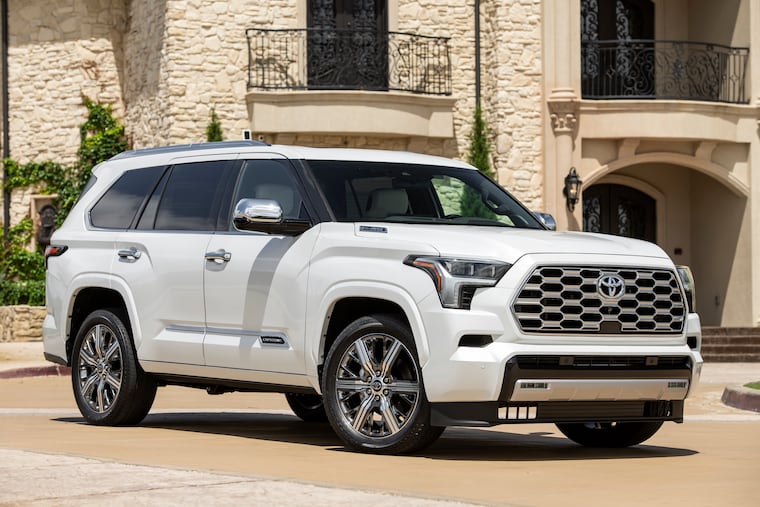2023 Toyota Sequoia: It took 15 years for this redesign?
The largest SUV from Toyota’s stable finally gets a new look. It looks pretty much the same, has actually gotten smaller, and is still thirsty despite a hybrid power plant. So what’s new?

2023 Toyota Sequoia 4WD TRD Pro Hybrid vs. 2024 Mazda CX-90 PHEV Premium Plus Package: Two wildly different ways to behemoth.
This week: 2023 Toyota Sequoia.
Price: $80,291 as tested. The TRD roof rack added $1,395; dash cam, $499; special color, $425; tow mirrors, $290.
Conventional wisdom: Motor Trend likes the “powerful iForce Max hybrid V-6 engine,” but not the “excessive cabin noise” and that it’s “too expensive at $80,000.”
Marketer’s pitch: “Resilient from the ground up.”
Reality: Bigger may be better, but better would really be better.
What’s new: All new from the ground up, the three-row Sequoia now rests atop the Toyota SUV behemoth lineup, after the Land Cruiser met its demise at the end of the 2021 model year.
It’s not like a new look wasn’t in order; the previous redesign came in 2008. But upon entering the cabin, it really looked like the 2019 model, save for the ginormous touchscreen.
Competition: In addition to the CX-90 (not really), there’s the GMC Yukon, Chevrolet Suburban and Tahoe, Nissan Armada, and Ford Expedition.
Up to speed: Toyota has filled the redwood-sized engine compartment with a twin-turbo V-6 mercifully attached to a power generator, designed to provide power and save some fuel. It produces a whopping 437 horses and 583 pound-feet of torque, pulling the driver and occupants forward with great force — and a pretty cool rumble to match.
The vehicle gets to 60 mph in an impressive 5.6 seconds, according to Car and Driver. Getting onto highways was no sweat. What’s more, pulling out in town and on side roads took some easing off the gas, lest I hit highway speeds in a 25-mph zone.
Shifty: The 10-speed transmission is controlled with a shifter designed for giant paws. Unfortunately, it sticks with Toyota’s policy of “no shifting fun allowed”; the shift mode only limits the top gear while running in automatic mode up to it.
On the road: The lack of shift capability disappoints because, surprisingly enough, the Sequoia is a fun and nimble beast, once you get some practice.
Upon first start-up, I acutely felt all the Sequoia’s ungainliness. The last time I’d driven one was through Nebraska and Iowa, where I had all the space I could stand (at least until it was time to park at the Iowa State Fair). My 2023 model showed up in Eco mode, which sacrifices handling for fuel savings.
But once I figured out how to find Sport mode — make sure the button is set to “drive mode” and then use the multifunction console dial — the Sequoia really became a fun companion. Country roads with mild curves and slight ups and downs feel great, and the bright orange test vehicle sailed through them with aplomb.
But it’s not all joy and elation; tighter turns remind you that orange is the color of Asplundh tree service trucks that pepper the region all through spring and summer, and the Sequoia might just fall over as easily as one of their victims.
Highways and bumpy roads vary from super bouncy (Normal and Eco mode) to brutally firm (Sport mode).
Off the road: We never had a chance to put the Sequoia into 4L for real off-roading, but 4H worked really nicely on the gravel farm roads snaking though western Chester County. The SUV kept a nice grip even on hills and sharp curves.
Driver’s Seat: The funky cloth-covered seat doesn’t provide the greatest comfort; I couldn’t get the lumbar off enough to my liking. Driving position is a little low as well; expect to make full use of the economy-size dual-view side mirrors. They really help with centering in your lane and seeing what’s going on.
Unfortunately, those same mirrors are so in the way when it’s time to pull out from a stop sign. I did a full swivel head every time I pulled out. And remember to tuck those elephant ears in on narrow bridges — fortunately, there’s a button for that.
Controls keep with the large plastic knobs and switches of the previous generation.
Friends and stuff: The second and third rows do not move. The second row is reasonably comfortable but the third is for kids. The ceiling is close, the floor is close, adults will be contorted into awkward configurations. If we’d had this for the six of us in 2019, there would have been a mutiny.
Cargo space is now 22.3 cubic feet in the back, 49 behind the second row, and 86.9 overall, down considerably from the previous generation.
On the bright side, towing capacity is much improved; it’s right around 9,000 pounds for four-wheel-drive models and 9,500 for two-wheel-drive, up more than 20% over the previous model tested.
Play some tunes: The 14-inch infotainment touchscreen really stands out — it’s almost all screen, too; there’s very little frame and the screen itself is not divided, nor is it super wide and short.
I was certain the Sequoia would get one of Toyota’s upgraded stereos, but it sounded almost as bad as the 2011 Sienna I’ve been complaining about for years now. We’re talking B-/C+ territory.
Fuel economy: That iForce hybrid is helping out; I averaged 15.6 mpg around town, about a 20% improvement over the previous model tested. Still, 20% of not much is not much at all.
Where it’s built: San Antonio, Texas.
How it’s built: Consumer Reports says the Sequoia earns a 3 out of 5 for reliability.
Next week: Not so big, not so pricey, not so thirsty is the Mazda CX-90.